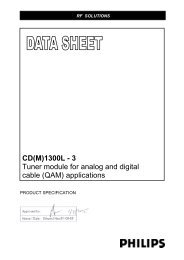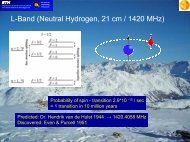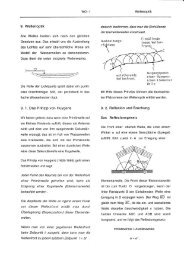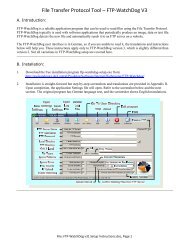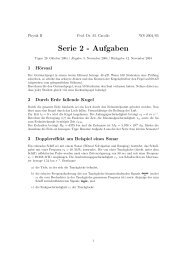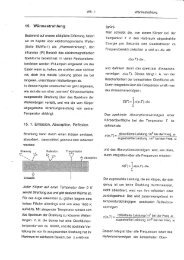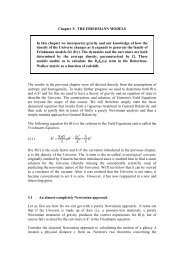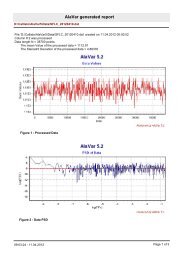here - Institute for Astronomy Umleitung
here - Institute for Astronomy Umleitung
here - Institute for Astronomy Umleitung
Create successful ePaper yourself
Turn your PDF publications into a flip-book with our unique Google optimized e-Paper software.
Title: Science Case<br />
Reference: MUSE-MEM-SCI-052<br />
Issue: 1.3<br />
Date: 04/02/2004<br />
Page: 21/100<br />
estimates (e.g. Gould & Weinberg 1996) suggest that the surface brightness of such regions<br />
which lie within filaments but outside of galaxies, could be substantial. In other words, Ly α<br />
emission should offer a better map of the gas distribution in filaments than galaxy surveys do.<br />
Furthermore, as pointed out by Haiman & Rees (2001), diffuse Ly α -emitting gas constitutes<br />
an intrinsically interesting phase: this gas is cooling onto virialized halos, thus offering a<br />
unique opportunity to study the growth of bound objects.<br />
The technique of selecting galaxy candidates in narrow band filters which was briefly<br />
described in the previous section is costly as it involves doing ultra deep imaging and then<br />
going to large telescopes to get a spectroscopic confirmation of the redshift. This makes<br />
MUSE highly competitive since the redshifts are obtained simultaneously across the entire<br />
field. In addition, the flux limit of 1.1 × 10 -17 erg s -1 cm -2 reached by Moller & Fynbo (2001)<br />
to detect their z = 3.04 filament is well above what MUSE will reach, either in shallow or<br />
deep mode (5 × 10 -18 erg s -1 cm -2 and 3.9 × 10 -19 erg s -1 cm -2 respectively) so that one could<br />
imagine doing a shallow survey covering quite a large portion of the sky without the adaptive<br />
optics, and still gain a lot as compared to current narrow band filter surveys (as e.g. LALA) in<br />
terms of mapping the cosmic web at high redshift. As an example, it is necessary to get<br />
accurate redshifts of objects to determine their membership in groups or filaments. Such<br />
redshifts will be obtained without further overhead from such a MUSE survey. Moreover, all<br />
currently planned Ly α surveys target a redshift window 4 < z < 5 (LALA or the SUBARU<br />
survey) or z~2 (NOT survey) and none cover the range z~3 w<strong>here</strong> MUSE will have<br />
significant sensitivity. Finally, as pointed out by Weidinger at al (2002) a decent size filament<br />
survey containing a few tens of objects could also be used to meaningfully constrain the value<br />
of Ω Λ , in a way that intersects the probability curves from the various SN Ia cosmology<br />
projects. Such constraints would be coming from a modified Alcock-Paczy’nski (1979) test,<br />
involving statistical geometrical properties of filaments (lengths, radii and angles). We refer<br />
to the original work of Weidinger et al (2002) <strong>for</strong> details on this specific aspect.<br />
Finally, to illustrate the most unique point of using an instrument such as MUSE, we take<br />
advantage of the recent work of Furlanetto et al (2003) who explored the possible detection of<br />
filaments through the detection of diffuse Ly α emission at low (z = 0.15) redshift using high<br />
resolution hydrodynamical simulations. Their study is summarized in figure 2-7 which shows<br />
a surface brightness map of a large portion of the cosmic web as well as the blow up of one of<br />
its filaments. As Kunth et al (2003) rightly argue, properly computing Ly α emission from star<strong>for</strong>ming<br />
galaxies is a strenuous task, but one can nevertheless obtain simple empirical<br />
estimates. Taking those of Furlanetto et al (2003) at face value (panel (b) of figure 1), the<br />
scale on the plot is easily converted into units of erg s -1 cm -2 arcsec -2 by a simple subtraction<br />
of 21.5 from the given colour tables, so that the bottom of the colour scale on the right hand<br />
side of the figure is simply 3 × 10 -21 erg s -1 cm -2 arcsec -2 . Assuming that the filament remains<br />
unchanged at z = 3, and simply taking into account the cosmological dimming factor <strong>for</strong><br />
surface brightness which scales like (1 + z) -4 , and the shrinking of apparent diameter, one<br />
realizes that MUSE in deep field mode (whether in AO mode or not) should be able to<br />
marginally detect such diffuse Ly α emission at z = 3. (See the calculation below on<br />
fluorescence <strong>for</strong> some more detailed numbers).




